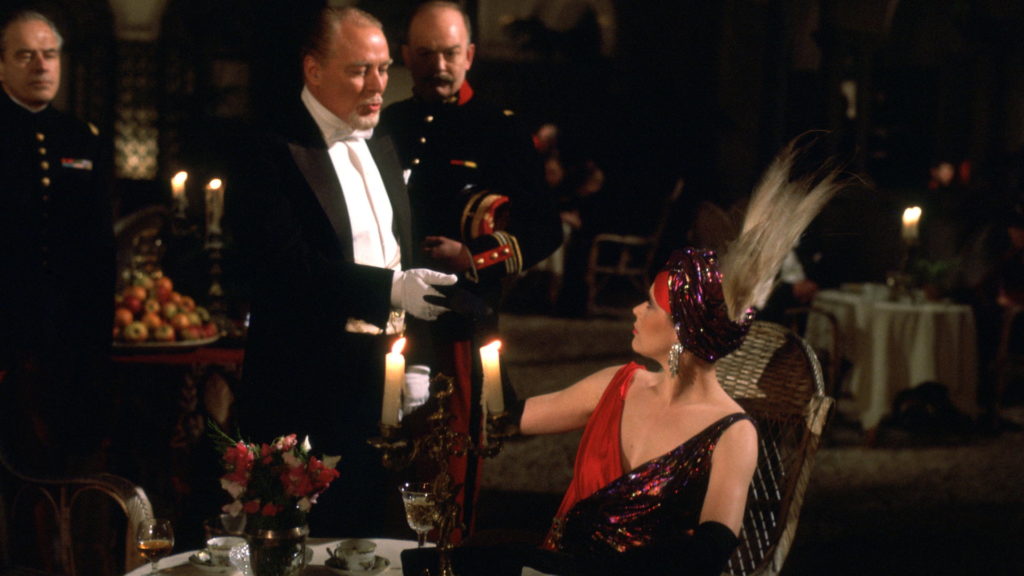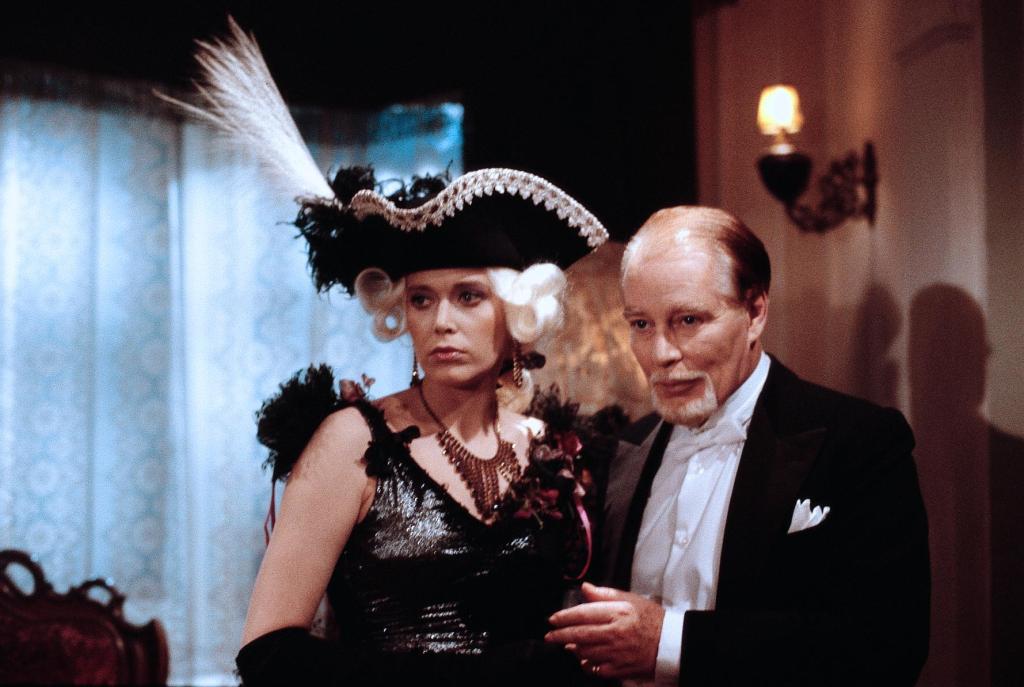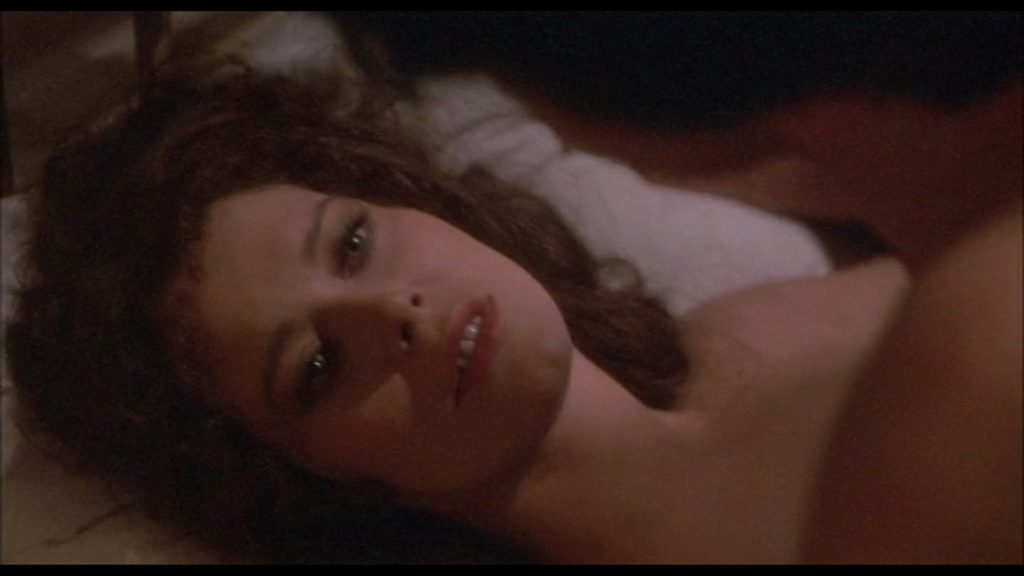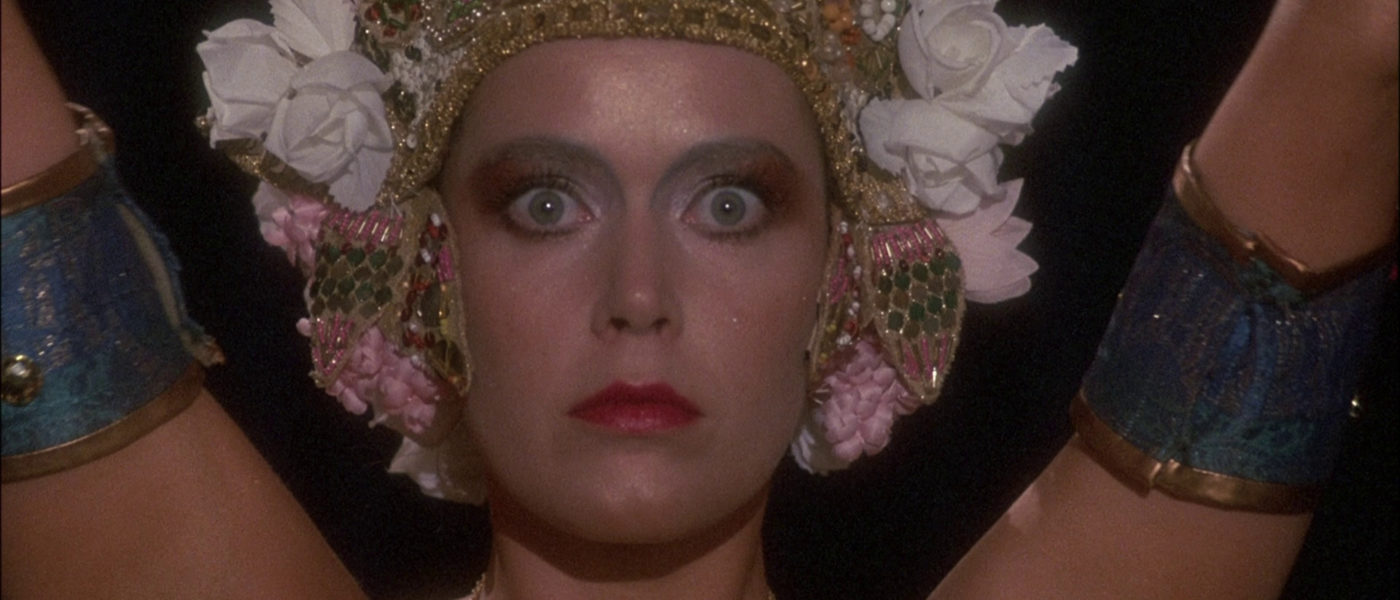Sylvia Kristel goes to war in Curtis Harrington’s sexy, Loosely Historical Drama
DIRECTED BY CURTIS HARRINGTON/1985
BLU-RAY STREET DATE: AUGUST 30, 2022/KL STUDIO CLASSICS

Why is it that when 1970s auteurs in the Netherlands would make a serious drama that’s long on sex and nudity, it plays as more legitimate, but when Menahem Golan and Yoram Globus make them that way a decade later, it feels trashy?
Gross intent is everything. For said producers Golan and Globus and their forever-frozen-in-time Cannon Films output, it can feel like a strangely particular kind of trashiness… like someone’s run through a classy dining hall just before a fine meal sloshing the contents of an industrial grease catcher all over the place.
It’s tempting to settle on that metaphor, but the truth is that for films like 1985’s Mata Hari, it’s the other way around. The contents of the grease catcher are sloshed down as the foundation. The ornate historical costume period drama is then put together on top of that. No one is wiser to this methodology than Mata Hari’s late director, Curtis Harrington (Whoever Slew Auntie Roo?). As Harrington devotees David Del Valle and Nathaniel Bell point out on their newly recorded audio commentary track, the filmmaker was under no illusions that despite its many upscale trappings, Golan and Globus had ultimately hired him to make a sex film. So that is what he made for them. Reportedly, it was a miserable experience. Sadly, it would be his final feature film.
In a bit of what coulda shoulda woulda been perfect casting is international Dutch film star Sylvia Kristel in the title role. Though rampantly famous in the 1970s thanks to her tastefully erotic mega-hit Emmanuelle, by the mid-1980s, Kristel’s vices- namely alcohol, cigarettes, and cocaine- were catching up with her. In Mata Hari, her default demeanor is one of sadness. Sadness with a troubling air of soullessness. This deadened woman is a far cry from the vibrant Kristel of, say, Julia or Frank & Eva. It becomes all the more glaring when one does a cursory reading about the real-life Mata Hari, a Dutch exotic dancer who was accused of spying on behalf of Germany during the First World War and costing the lives of thousands upon thousands of French soldiers.

Just as is the case with the several other films about the alluring entertainer (the most famous starring Greta Garbo, from 1931), this one tells the popular myth. Today, historians have cast strong, plausible doubt on whether Mata Hari (whose real name was Margaretha MacLeod, as she’s often referenced in this film) was ever a spy at all. But hey, that’s no fun! When it comes to sexy spies who ignite the whole notion of the “femme fatale”, storytellers manipulate and cherry-pick the history, not accurately deconstruct it. Case in point: According to George Lucas’ Young Indiana Jones Chronicles, the adventurer was deflowered by none other than Mata Hari. One true point that remains in every telling: at age forty-one, she was shot dead by a French firing squad. (Though Warner Bros. couldn’t bring itself to actually show Garbo being bound and executed. That one ends when she is escorted out of her cell and to her demise).
Kristel’s resemblance to the real Margaretha MacLeod is passable at best (particularly inaccurate is her fuller body type), though her Dutch heritage and reputation as a sexual movie star make her thoroughly ideal for the role. In theory. While film historians Del Valle and Bell are on hand primarily due to their expertise on the diversely historied Harrington (Del Valle has firsthand knowledge, having been a friend of the director), they are no slouches when it comes to the star and the real-life woman she’s portraying. They talk of how Kristel had hopes of this layered role in this fairly lavish period piece would finally elevate her beyond Emmanuelle. How disheartening, then, for her to find herself removing her top quite often throughout this picture. (Ironically, per historical recollection, her ornate tops were the only thing that the randy Mata Hari wouldn’t take off, being so self-conscious of her smaller chest).
That fact assures that the film’s topless rapier duel, fought between Kristel’s character and an angry young noblewoman we’ve only just met, is the stuff of complete and total fabrication. In actuality, this scene very much appears to be an appropriation of the infamous topless duel of 1892 between Austrian nobles Princess Pauline von Metternich and Countess Anastasia Kielmansegg. It’s said that the princess and the countess were advised to sword fight topless to avoid possible infections that would result from having their unwashed gowns stabbed into their skin. The source of their lethal ire? A disagreement over floral arrangements.

While that fact remains unforgettable, I do not recall what they were dueling over in Mata Hari… despite having just watched it. But still, as far as over-the-top sensationalism goes in this otherwise unengaging film, the sword fight is, by radical default, the standout point. Its best part is the way Kristel slashes her opponent, turns her back, strides away, and receives her waiting top all in one cool gesture. That’s just how dynamic Kristel and Mata Harican be. Unfortunately, they don’t seem terribly moved to be very dynamic very often. Harrington goes so far to telegraph his campy intentions in his operatic staging of several sex scenes punctuated with thunder cracks and lightning, like some kind of gothic vampire movie. The rest of Mata Hari, though, fails to follow through on such amusing sensibility.
While it should be obvious at this point that Harrington’s Mata Hari is no great shakes, the Del Valle/Bell commentary is fully worth the price of admission. With personal anecdotes and insights aplenty (not to mention Del Valle’s default, not always flattering Harrington impression), this continuous discussion between enthusiastic friends is a great and even fun listen. When Mata Hari is spinning its wheels on the many boring scenes of (as Del Valle puts it) “people eating in restaurants and talking”, the historians chat a good bit about Josef Von Sternberg (whom Harrington had been affiliated with) in the meantime. Theatrical trailer and optional English subtitles aside, the commentary is the disc’s only bonus feature.

While it is decided early on that this is the edited U.S. cut of the film, I come away a little confused about this. In my admittedly very limited research, I read a quote in which Harrington himself lamented the stateside censoring of fully frontal human statuary at an orgy. That shot is in this version, as is no shortage of sexual material. It’s generally somnambulistic sexual material, but it is here. That said, I’ll ultimately defer to Del Valle and Bell’s assumptions about the film, as they reiterate throughout that up to seven minutes of even steamier footage is said to have gotten axed. Perhaps Harrington was misquoted, or he recalled what got cut incorrectly? The question persists, then, of where this longer European version is. Usually if Kino Lorber can include alternate cuts of films, it does so. Perhaps the nice slipcover packaging will make up for its absence…?
KL Studio Classics’ Blu-ray edition of Mata Hari is a visually handsome affair. That smoky mid-1980s aesthetic is rendered quite impressively in high definition. Harrington got solid milage out of his Hungarian filming locales (doubling for points all over the globe, including a well-staged scene of World War I trench warfare chaos), and they look terrifically tactile. Likewise, though, is the palpable quality of behind-the-scenes sadness baked into the picture. Kristel nor Harrington found this to be a satisfying experience, and even more sadly, it would cap the career of the latter. For them, Mara Hari was a figurative death by an altogether different kind of firing squad.


